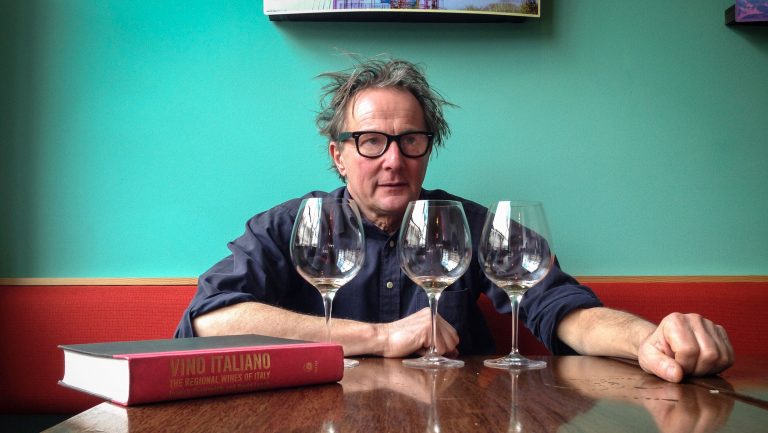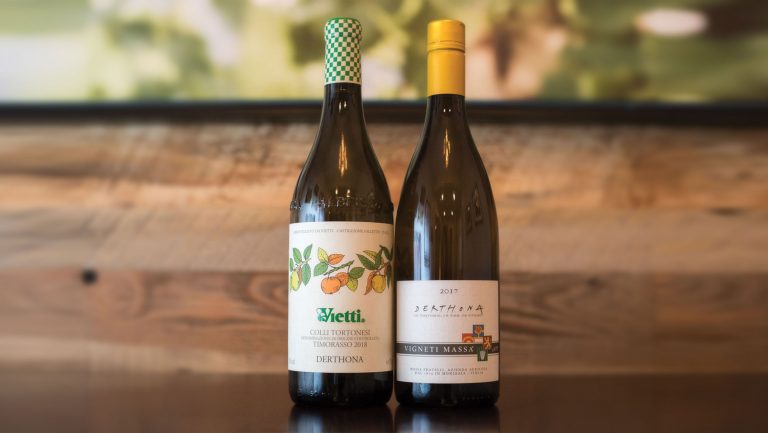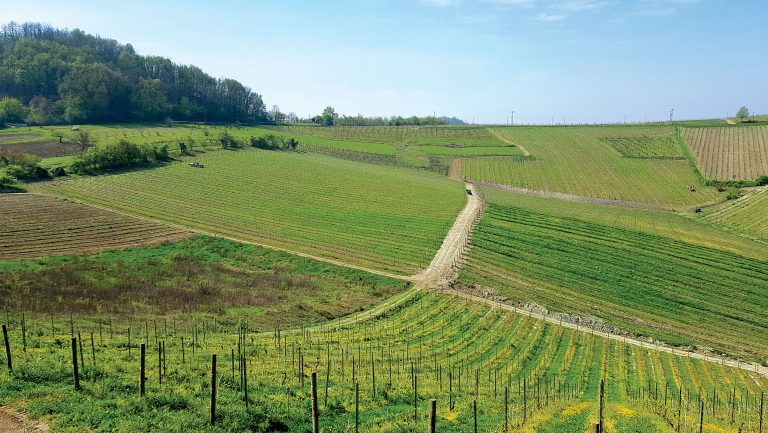While Piedmont boasts an enormous range of unique grapes, much of the world’s attention has been centered on its red varieties, including Nebbiolo and Barbera. Despite regional winemakers’ efforts to diversify their red-heavy portfolios with the likes of Arneis, Nascetta, or even Chardonnay and Riesling, broad acclaim for Piedmontese white wines has been relatively scant. But now it appears that consensus is forming around the future of Piemontese white wine, and that future is Timorasso.
“I personally think it is the most interesting indigenous white variety in Italy,” says Pietro Oddero of the eponymous Barolo-based winery. In recent years, Pietro and his cousin, Isabella Oddero, have partnered with More e Macine, a local osteria in their hometown of La Morra, to acquire Timorasso vineyards in the Colli Tortonesi near Tortona, the grape’s heartland.
Oddero is not alone. Some of the most prestigious producers in the Langhe and Monferrato—including Borgogno, Roagna, Scarpa, Vietti, and, most recently, Pio Cesare—have boarded the Timorasso bandwagon. In each case, they’ve learned from local winegrowers—particularly the grape’s biggest advocate, Walter Massa of Vigneti Massa—to better understand the grape, how to manage it in the vineyard, and how to get the most from it in the winery.

Don’t miss the latest drinks industry news and insights. Sign up for our award-winning newsletters and get insider intel, resources, and trends delivered to your inbox every week.
“Timorasso is a grape variety that has a lot of personality,” says Vietti’s winemaker Luca Currado, who recently debuted that winery’s inaugural vintage of the variety after experimenting with it for three years. “I would compare it to Chenin Blanc—a white with good tannin.”
The small but growing list of Timorasso bottlings available in the U.S. has been embraced by wine buyers. “Timorasso is such a versatile wine to pair with food,” says Mariarosa Tartaglione, wine director at Manhattan’s Michelin-starred Ai Fiori. She also notes that its crisp acidity, structure, and “not-so-overwhelming aromatics” easily complement her restaurant’s rich seafood dishes. “I think Timorasso has all the credentials for being a great wine.”
Lauren Hayes, general manager and wine director at Pammy’s in Cambridge, Massachusetts, agrees. “I trust Timorasso with a lot of different types of drinkers. It is not just for the whimsical and curious,” she says.

Walter Massa and Timorasso’s Resurrection
As is so often the case in Italy, the Timorasso grape was hiding in plain sight, and it has a single vintner to thank for its resurrection: Walter Massa.
And its homeland, Colli Tortonesi, is what Ernest Ifkovitz, the founder of importer PortoVino, calls Piedmont’s “hinterland.” Located along Piedmont’s border with Lombardy, Liguria, and Emilia-Romagna, the Colli Tortonesi region has long been overshadowed by the Langhe Hills and their iconic appellations of Barolo and Barbaresco. Commonplace Barbera and tepid Cortese were the Colli Tortonesi region’s calling cards through the 1970s and ’80s, until Massa began embracing—and fervently promoting—the virtues of Timorasso.
Massa recalls being quickly captivated in 1988 when he first started experimenting with the variety. “It was one of the few times in my life when I thought of things not as a farmer, but as an entrepreneur,” he recalls. “I said ‘this wine, it has to give back the money I put into it.’”
Massa’s primary wine at the time, a Barbera, sold for 4,000 Italian lira—the equivalent of 2 euros per bottle. So to convey a message about Timorasso’s quality, Massa priced his first vintage at 8,000 Italian lira. Although it would take years to produce enough wines to win the hearts and minds of Italian-wine connoisseurs, he knew he was on to something.
By the early 1990s, Massa was calling his Timorasso wines “Derthona”—a reference to the ancient Latin name for the nearby city of Tortona. He subsequently registered it as a trademark.
Word of Massa’s work with the variety began to spread in the region, and other winegrowers in the Colli Tortonesi began to pursue Timorasso. Andrea Mutti and La Colombera started their Timorasso plantings in the late 1990s. Ezio Poggio followed in 2004. “They all learned at the altar of Walter,” says Ifkovitz. From Massa’s original three hectares near Monleale in 1988, plantings of Timorasso now cover nearly 600 hectares of the Colli Tortonesi.

Timorasso Fever Spreads
Massa cultivated interest in neighboring regions—such as the Langhe and Monferrato—by leaving bottles with winemakers he visited. They were impressed by Timorasso’s complexity, structure, and ageability.
“We were talking about the rise of Timorasso in La Morra,” recalls Pietro Oddero of the Barolo estate Oddero “I personally think that the quality has risen a lot over there in the last 10 years.”
Oddero likens this quality revolution to what happened in Barolo 60 to 70 years ago, but he stresses emphatically that the Colli Tortonesi producers deserve the credit for the recent surge in quality. “I am going there to learn about Timorasso. That’s very important to know.”
Elena Currado of Vietti noted that Walter Massa was instrumental in many aspects of Vietti’s Timorasso project as well, including finding the right vineyard land and providing insight on winemaking technique. “He has helped all of the producers,” she notes, adding that the energy of the Colli Tortonesi winemakers has been inspiring for her and her husband, Luca.
Massa’s embrace of new producers—particularly the newcomers from the Langhe and Monferrato—is partly driven by a desire to see more export markets open, which is an essential next step for the grape. He has even allowed them to use his trademarked name “Derthona” for their wines, an effort to build the brand for the grape’s unique terroir in the high-elevation hills of Tortona. (There is an effort now to codify the use of “Derthona” in the Colli Tortonesi regulations, which should be defined and rolled out by 2021.)
Massa currently offers three single-vineyard Timorasso, but with Vietti already eyeing a possible Timorasso cru bottling in the future, the prospect of a fine-wine market for Timorasso could become a reality.

Timorasso on the Wine List
In Piedmont, there is a growing awareness that Timorasso may possess a greater ability to age and achieve complexity more than almost any other Italian white variety, but American sommeliers are embracing these wines now for their value.
As Hristian Iliev’s restaurant Carbone in the Aria Las Vegas reopens after a months-long hiatus from the coronavirus, the sommelier notes that Timorasso will play an important part for guests seeking a high-quality white wine for a reasonable price.
“For the more savvy wine consumers who are into Rieslings or Chenins, I think Timorasso continues to stand up for them because it is value-driven, character-driven, and a friendly wine because of its richness,” Iliev explains. “People are missing human interaction and conversation and exploration with the wine world. For them, I think Timorasso will do very, very well.”
Mariarosa Tartaglione of Ai Fiori agrees that Timorasso’s charms easily cross over to savvy consumers who are already familiar with Chablis or dry Chenin Blanc from the Loire. She frequently recommends the wine to guests seeking an alternative to Chardonnay.
But Lauren Hayes of Pammy’s embraces the adventurous side of Timorasso, even offering a skin-contact orange version from producer Daniele Ricci called “Io Cammino Solo” when she can. She has come to the conclusion that “only having one Timorasso on the list doesn’t sell Timorasso. Three Timorassos sell Timorasso.” But she wonders: Is three Timorassos on a wine list too many for a grape that is still relatively unknown?
According to Massa, who learned of Hayes’s passion for the grape and its triple placement on her wine list, “No, it is not!”

Dispatch
Sign up for our award-winning newsletter
Don’t miss the latest drinks industry news and insights—delivered to your inbox every week.
Kevin Day is a wine writer and photographer based in Colorado and the founder of the wine website Opening a Bottle. He is an Italian Wine Scholar with Highest Honors and a member of the International Association of Culinary Professionals. Follow him on Instagram and Twitter @openingabottle.






